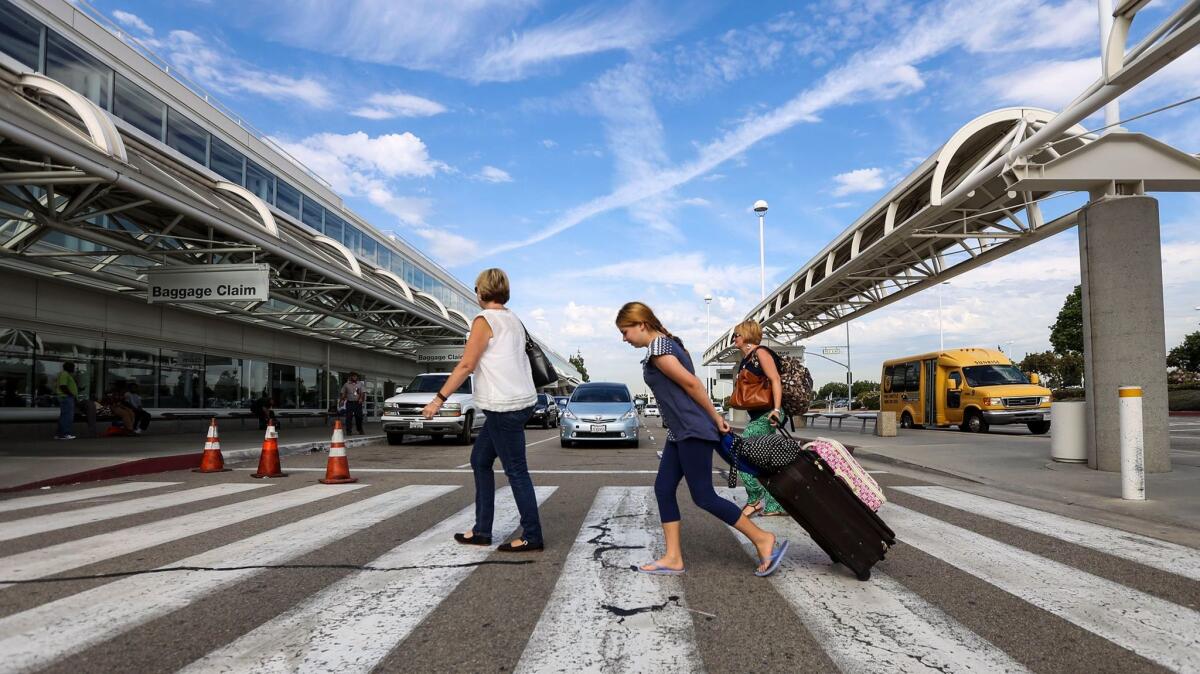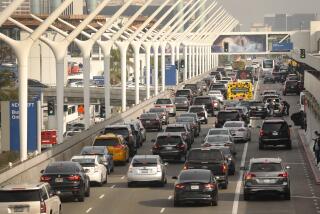Lower fares from the Inland Empire are just one of the reasons things are looking up. The future looks bright for the little airport that could.

- Share via
Recently the round-trip airfare from LAX to Phoenix clocked in at $162, including all taxes and fees.
Meanwhile, the airfare from Ontario International Airport to Phoenix came in at — wait for it — $162.
What’s going on here? Some kind of airline duplicity (perish the thought)? Has the world as we know it rotated off its axis?
We wondered because fares from Ontario have almost always been higher, sometimes much higher.
Welcome to the world of Ontario Airport under local control, where things appear to be looking up for fliers in the Inland Empire as well as refugees from LAX.
Ontario Airport used to be part of Los Angeles World Airports, but in November ownership was turned over to the city of Ontario.
There was much backing-and-forthing as the change was being effected, but most of the squabbles and struggles don’t affect consumers directly.
Here are some things that do:
►You may pay less to fly out of Ontario. Using data from the airfare chart published in the Los Angeles Times Travel section, we looked at round-trip fares from Ontario to Las Vegas, Phoenix and Honolulu for the six months of Sundays before and after the handover.
The results:Round-trip fares from Ontario to Las Vegas had dropped from an average of $194 to $134.
Average fares to Phoenix? $167, down from $205.
The fares to Honolulu went up by $3 on average, partly because of a six-week stretch when those fares hit $1,065. If you factor out those weeks, the fare dropped to an average of $738, down from $824.
You can’t credit local control for all this. Airline competition, lower fuel prices, consumer demand and the mystery/science of yield management, in which airlines try to get consumers to pay top dollar if conditions warrant it, are all in play.
But changes at the airport also figure into the fare joy, said Alan Wapner, president of the Ontario Airport Authority and mayor pro tem of Ontario.
Among the airport authority’s goals, Wapner said: Decrease expenses and increase non-aviation revenue from parking and other sources.
“Those two things will bring down the cost of doing business and translate into lower fares,” Wapner said.
Besides decreasing the size of airport staff, parking fees were increased and parking lots automated. Food and beverage and other concessionaire contracts were renegotiated, Wapner said.
Add to that an increase in number of flights and ...
►You have more company at Ontario. Passenger traffic is up after a sharp decline.
In 2007, Ontario served 7.2 million passengers. Then that number plummeted, partly because of the recession, to a little less than 4 million by 2013.
As with any business, the airport needs customers. And although anyone who uses a horrendously busy over-capacity airport wouldn’t complain about fewer passengers, a drop like that hurts, especially when you think about revenue that’s not related to airlines.
Nearly 4.3 million passengers used Ontario in 2016. That uptick began in 2014, before local control resumed. Other factors also influence the choice of airport, of course, including fares, schedules and convenience.
The trend continues. Recently released figures for August show that traffic was up again year over year by almost 40,000 domestic and international passengers.
►You like Ontario airport, which is good because happier fliers are more apt to be repeat fliers.
Take Karen Rosenthal of Claremont, who is enthusiastic about the airport. “It takes us 30 minutes, front door to gate, when flying to [the] Bay Area or Sacramento or Seattle et al,” she said in an email.
“Lots of parking, curb unloading space, quick check-in and efficient [Transportation Security Administration] with increased flights and additional airlines now that [Ontario] is under local control. It may be worth the drive from L.A.!”
A recent J.D. Power airport survey suggests that Rosenthal has plenty of company. Ontario scored 782 out of 1,000 points among medium-size airports among travelers in a satisfaction survey conducted from January through August. The results factor in terminal facilities, airport access, security check, baggage claim, baggage check-in and food, beverage and retail. The average was 781, so we can say Ontario is above average. Albuquerque, Cleveland and San Antonio cannot.
Meanwhile, beleaguered LAX, at 712, was second to last in the mega-airport satisfaction category, above Newark, N.J.
If there is a downside to the Ontario love and a lesson from LAX, it’s this: Success begets success.
LAX set a record for number of passengers in 2000, at 63.7 million. Last year, that passenger number was nearly 71 million, according to an L.A. Times article based on a Southern California Assn. of Governments report.
Even more frightening, LAX could top 100 million passengers by 2040, the association predicted. If that sounds like the distant future, the math pencils out to just 23 years.
Ontario, meanwhile, has room to grow. It can handle 12 million passengers, Wapner said, so for now, it’s using only about a third of its capacity.
He recognizes that one of the challenges will be whether the airport can “maintain that level of convenience once we meet 12 million passengers or more.”
Always a good idea to keep an eye on today and tomorrow, if LAX is any indication.
But for now, we can sit back and enjoy the ride.
Have a travel question or dilemma? Write to [email protected]. We regret we cannot answer every inquiry.
More to Read
Sign up for The Wild
We’ll help you find the best places to hike, bike and run, as well as the perfect silent spots for meditation and yoga.
You may occasionally receive promotional content from the Los Angeles Times.







